Abstract
Increased blood viscosity has been shown to be an important factor in reducing blood flow in a review and analysis of the history, clinical findings, and haemodynamic, rheological, radiological, and biochemical measurements in 126 patients with intermittent claudication. In some patients increased viscosity seemed to be the determining cause of claudication. A raised plasma fibrinogen was the most common single biochemical abnormality. The results of conventional serum lipid and lipoprotein estimations were abnormal in the series as a whole but did not correlate with clinical findings or flow measurements at individual patient level. There was, however, a significant correlation between some clinical findings and the susceptibility of the red cells to autoxidation.
Full text
PDF
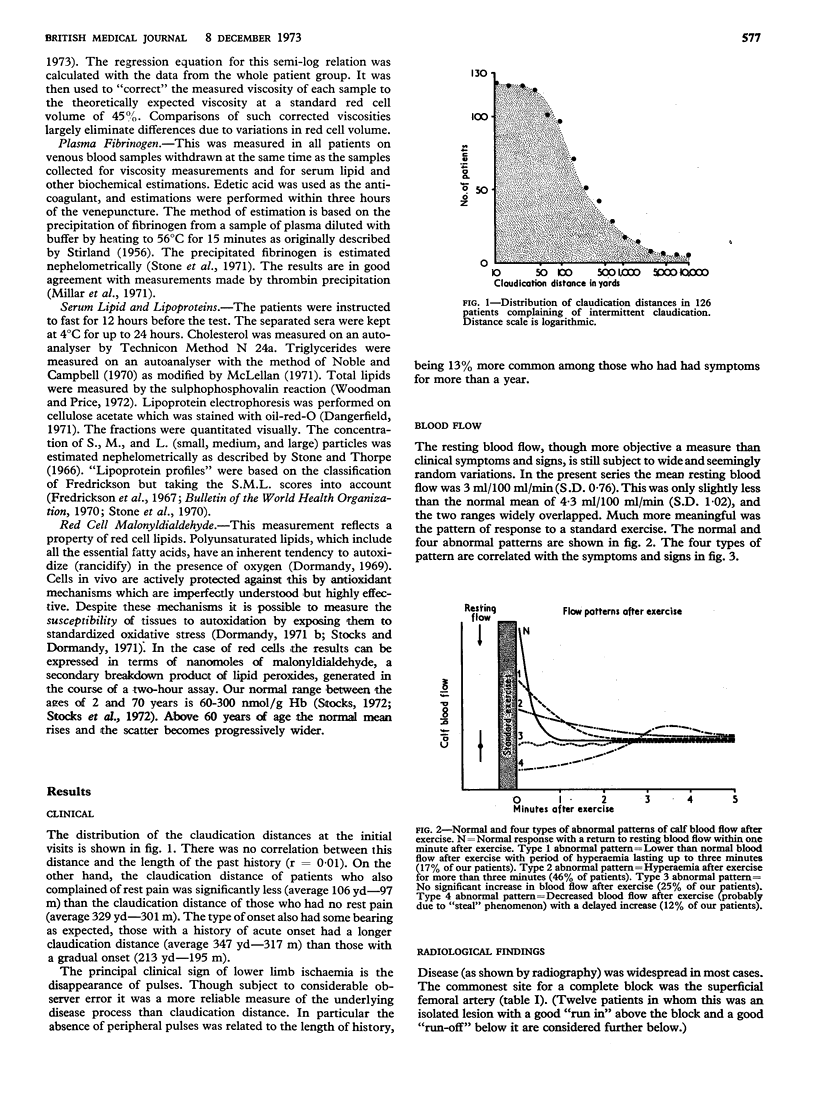
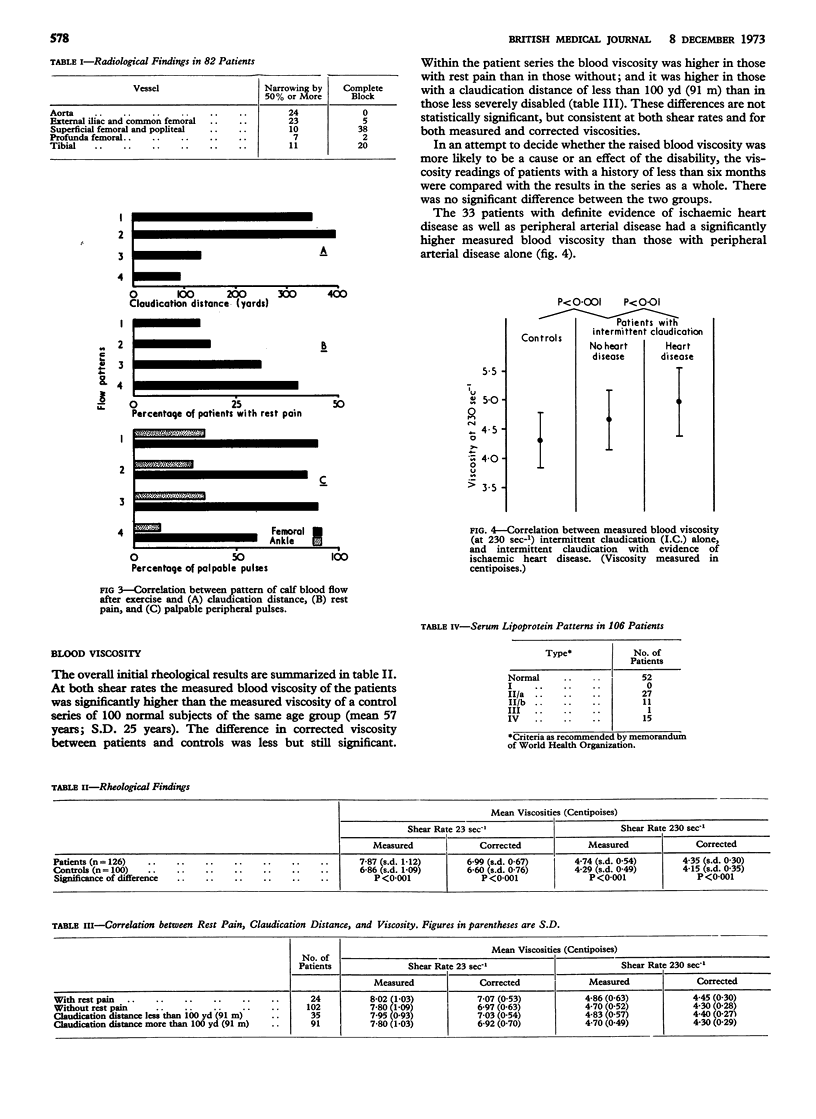
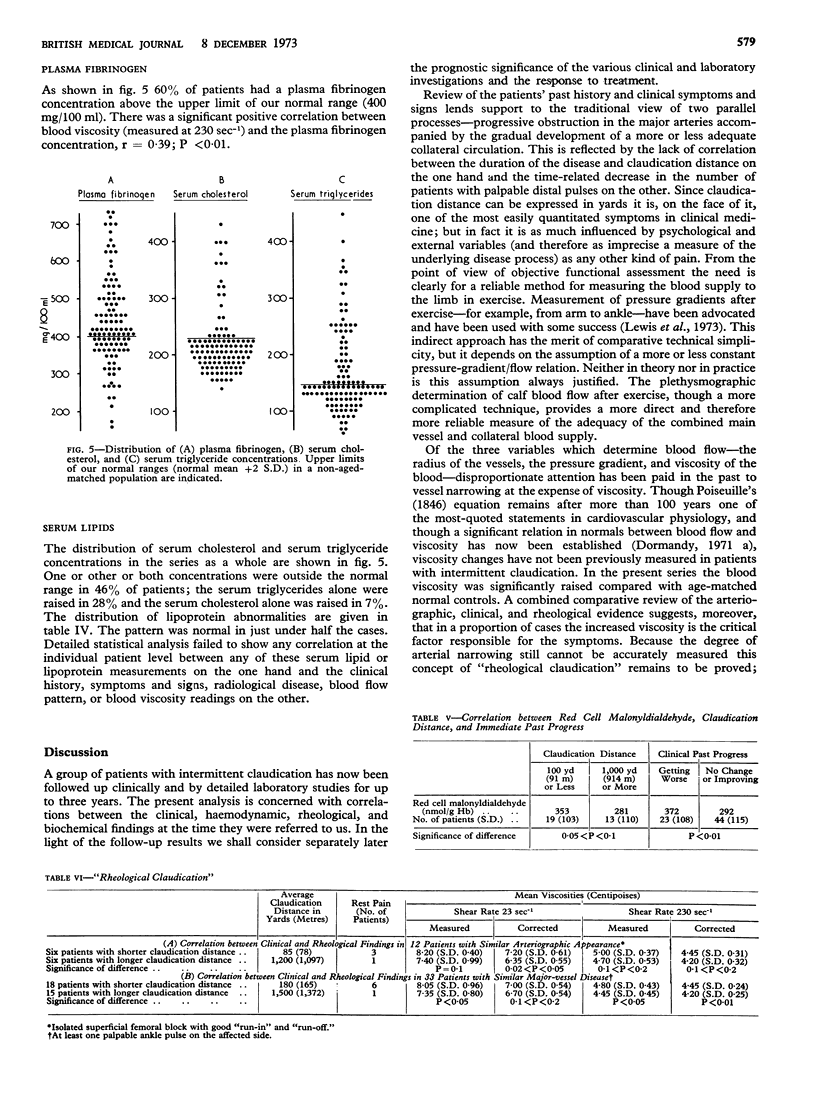
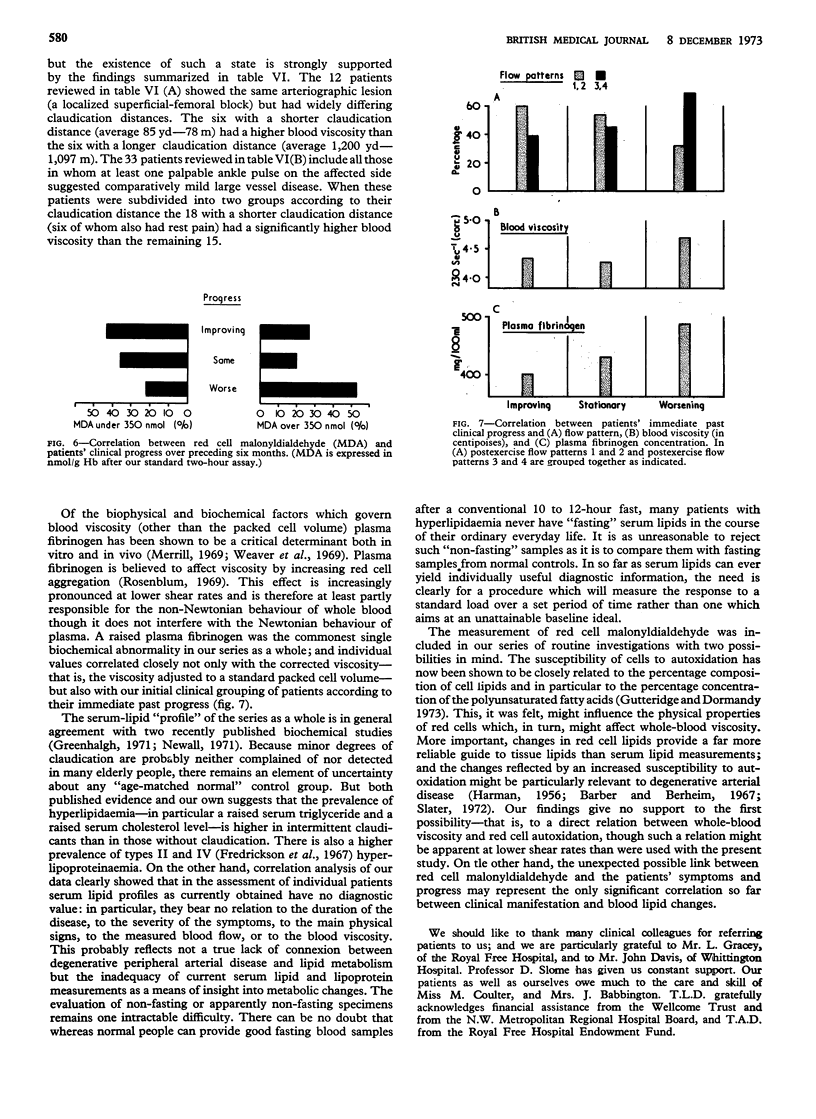
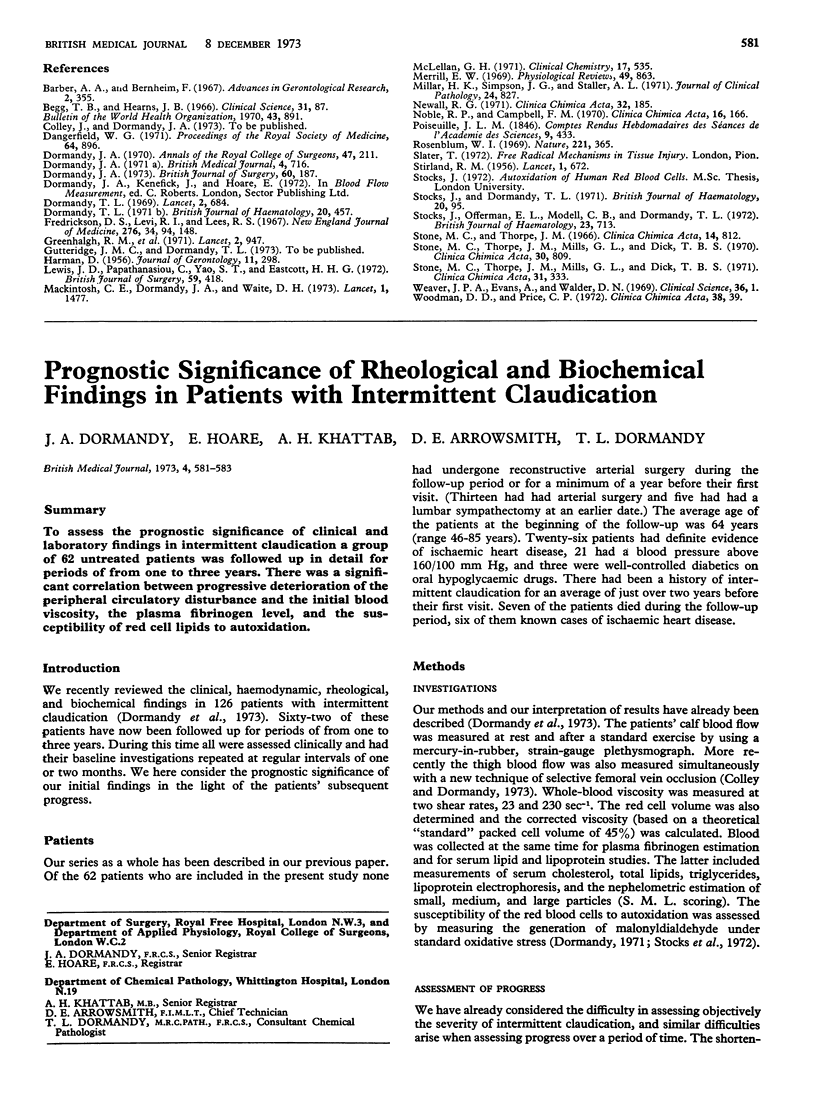
Selected References
These references are in PubMed. This may not be the complete list of references from this article.
- Barber A. A., Bernheim F. Lipid peroxidation: its measurement, occurrence, and significance in animal tissues. Adv Gerontol Res. 1967;2:355–403. [PubMed] [Google Scholar]
- Begg T. B., Hearns J. B. Components in blood viscosity. The relative contribution of haematocrit, plasma fibrinogen and other proteins. Clin Sci. 1966 Aug;31(1):87–93. [PubMed] [Google Scholar]
- Dormandy J. A., Edelman J. B. High blood viscosity: an aetiological factor in venous thrombosis. Br J Surg. 1973 Mar;60(3):187–190. doi: 10.1002/bjs.1800600306. [DOI] [PubMed] [Google Scholar]
- Dormandy J. A. Influence of blood viscosity on blood flow and the effect of low molecular weight dextran. Br Med J. 1971 Dec 18;4(5789):716–719. doi: 10.1136/bmj.4.5789.716. [DOI] [PMC free article] [PubMed] [Google Scholar]
- Dormandy T. L. Biological rancidification. Lancet. 1969 Sep 27;2(7622):684–688. doi: 10.1016/s0140-6736(69)90390-0. [DOI] [PubMed] [Google Scholar]
- Fredrickson D. S., Levy R. I., Lees R. S. Fat transport in lipoproteins--an integrated approach to mechanisms and disorders. N Engl J Med. 1967 Jan 19;276(3):148–contd. doi: 10.1056/NEJM196701192760305. [DOI] [PubMed] [Google Scholar]
- Greenhalgh R. M., Rosengarten D. S., Mervart I., Lewis B., Calnan J. S., Martin P. Serum lipids and lipoproteins in peripheral vascular disease. Lancet. 1971 Oct 30;2(7731):947–950. doi: 10.1016/s0140-6736(71)90269-8. [DOI] [PubMed] [Google Scholar]
- HARMAN D. Aging: a theory based on free radical and radiation chemistry. J Gerontol. 1956 Jul;11(3):298–300. doi: 10.1093/geronj/11.3.298. [DOI] [PubMed] [Google Scholar]
- Lewis J. D., Papathanaiou C., Yao S. T., Eastcott H. H. Simultaneouus flow and pressure measurements in intermittent claudication. Br J Surg. 1972 Jun;59(6):418–422. doi: 10.1002/bjs.1800590603. [DOI] [PubMed] [Google Scholar]
- Mackintosh C. E., Dormandy J. A., Waite D. Stress arteriography. Lancet. 1973 Jun 30;1(7818):1477–1479. doi: 10.1016/s0140-6736(73)91814-x. [DOI] [PubMed] [Google Scholar]
- McLellan G. H. Automated colorimetric method for estimating serum triglycerides. Clin Chem. 1971 Jun;17(6):535–537. [PubMed] [Google Scholar]
- Millar H. R., Simpson J. G., Stalker A. L. An evaluation of the heat precipitation method for plasma fibrinogen estimation. J Clin Pathol. 1971 Dec;24(9):827–830. doi: 10.1136/jcp.24.9.827. [DOI] [PMC free article] [PubMed] [Google Scholar]
- Newall R. G. A lipid and lipoprotein study of patients with peripheral arterial disease, using micro-nephelometry. Clin Chim Acta. 1971 Apr;32(2):185–190. doi: 10.1016/0009-8981(71)90330-5. [DOI] [PubMed] [Google Scholar]
- Noble R. P., Campbell F. M. Improved accuracy in automated fluorometric determination of plasma triglycerides. Clin Chem. 1970 Mar;16(3):166–170. [PubMed] [Google Scholar]
- Rosenblum W. I. "Viscosity-plus" effect in whole blood at high shear rates. Nature. 1969 Jan 25;221(5178):365–366. doi: 10.1038/221365a0. [DOI] [PubMed] [Google Scholar]
- STIRLAND R. M. A rapid method of estimating fibrinogen. Lancet. 1956 May 12;270(6924):672–672. doi: 10.1016/s0140-6736(56)90699-7. [DOI] [PubMed] [Google Scholar]
- Stocks J., Offerman E. L., Modell C. B., Dormandy T. L. The susceptibility to autoxidation of human red cell lipids in health and disease. Br J Haematol. 1972 Dec;23(6):713–724. doi: 10.1111/j.1365-2141.1972.tb03486.x. [DOI] [PubMed] [Google Scholar]
- Stone M. C., Thorp J. M., Mills G. L., Dick T. B. Comparison of membrane filtration and nephelometry with analytical ultracentrifugation, for the quantitative analysis of low density lipoprotein fractions. Clin Chim Acta. 1970 Dec;30(3):809–828. doi: 10.1016/0009-8981(70)90279-2. [DOI] [PubMed] [Google Scholar]
- Stone M. C., Thorp J. M., Mills G. L., Dick T. B. Diagnosis and classification of abnormal lipoprotein patterns. Clin Chim Acta. 1971 Feb;31(2):333–354. doi: 10.1016/0009-8981(71)90402-5. [DOI] [PubMed] [Google Scholar]
- Weaver J. P., Evans A., Walder D. N. The effect of increased fibrinogen content on the viscosity of blood. Clin Sci. 1969 Feb;36(1):1–10. [PubMed] [Google Scholar]
- Woodman D. D., Price C. P. Estimation of serum total lipids. Clin Chim Acta. 1972 Apr;38(1):39–43. doi: 10.1016/0009-8981(72)90205-7. [DOI] [PubMed] [Google Scholar]


